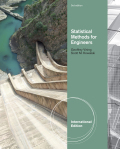
STATISTICAL METHODS FOR ENGINEERS, 3e, International Edition offers a balanced, streamlined one-semester introduction to Engineering Statistics that emphasizes the statistical tools most needed by practicing engineers. Using real engineering problems with real data based on actual journals and consulting experience in the field, students see how statistics fits within the methods of engineering problem solving. The text teaches students how to think like an engineer at analyzing real data and planning a project the same way they will in their careers. Case studies simulate problems students will encounter professionally and tackle on long-term job projects. The presentation makes extensive use of graphical analysis, and use of statistical software is encouraged for problem-solving to illustrate how engineers rely on computers for data analysis. The authors relate their own extensive professional experience as engineers inshort margin notes called Voice of Experience that lend valuable context to how students will apply concepts in the field and why they're important to learn. And a rich companion website provides hours of multimedia lecture presentation narrated by the authors to show the material related live by different voices, simulating how students will listen and learn from multiple colleagues intheir jobs. A flexible organization allows instructors to emphasize the topics they need and cater the presentation to different engineering majors in their courses. INDICE: 1. ENGINEERING METHOD AND DATA COLLECTION. Need for Statistical Methods in Engineering. Engineering Method and Statistical Thinking. StatisticalThinking and Structured Problem Solving. Models. Obtaining Data. Sampling. Basic Principles of Experimental Design. Examples of Engineering Experiments. Purpose of Engineering Statistics. Case Study: Manufacture of Writing Instruments. Ideas for Projects References. 2. DATA DISPLAYS. Importance of Data Displays. Stem-and-Leaf Displays. Boxplots. Using Computer Software. Using Boxplots to Analyze Designed Experiments. Case Study. Need for Probability and Distributions. Ideas for Projects References. 3. MODELING RANDOM BEHAVIOR. Probability.Random Variables and Distributions. Discrete Random Variables. Continuous Random Variables. The Normal Distribution. Random Behavior of Means. Random Behavior of Means When the Variance Is Unknown. Normal Approximation to the Binomial. The Weibull Distribution for Reliability Applications. Case Study References. 4. ESTIMATION AND TESTING. Estimation. Hypothesis Testing. Inference for a Single Mean. Inference for a Single Proportion. Inference for Two Independent Samples. The Paired t-Test. Inference for Two Proportions. Inference for Variances. Transformations and Nonparametric Analyses. Case Study. Ideas for Projects References. 5. CONTROL CHARTS AND STATISTICAL PROCESS CONTROL. Overview. Specification Limits. X- and R-Charts. X- and s²-Charts. X-Chart. np-Chart. c-Chart. Average Run Lengths. Standard Control Charts with Runs Rules. CUSUM and EWMA Charts. Basic Process Capability Indices. The SPC Approach to Gage R Studies. Case Study. Ideas for Projects References. 6. LINEAR REGRESSION ANALYSIS. Relationships Among Data. Simple Linear Regression. Multiple Linear Regression. Residual Analysis. Collinearity Diagnostics. Case Study. Ideas for Projects References. 7. INTRODUCTION TO 2k FACTORIAL-BASED EXPERIMENTS. The 2² Factorial Design. The 2k Factorial Design. Fractions of the 2k Factorial Design. Case Study. Ideas for Projects References. 8. INTRODUCTION TO RESPONSE SURFACE METHODOLOGY. Sequential Philosophy of Experimentation. Central Composite Designs. Box-Behnken Designs. Multiple Responses. Experimental Designs for Quality Improvement. Case Study. Ideas for Projects References. 9. CODA. The Themes of This Course. Integrating the Themes. Statistics and Engineering. Appendix. Tables.
- ISBN: 978-0-538-73723-4
- Editorial: Brooks-Cole
- Encuadernacion: Rústica
- Páginas: 648
- Fecha Publicación: 01/03/2010
- Nº Volúmenes: 1
- Idioma: Inglés
